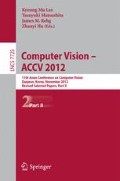Abstract
The aim of this work is to decompose shapes into parts which are consistent to human perception. We propose a novel shape decomposition method which utilizes the three perception rules suggested by psychological study: the Minima rule, the Short-cut rule and the Convexity rule. Unlike the previous work, we focus on improving the convexity of the decomposed parts while minimizing the cut length as much as possible. The problem is formulated as a combinatorial optimization problem and solved by a quadratic programming method. In addition, we consider the curved branches which introduce “false” concavity. To solve this problem, we straighten the curved branches before shape decomposition which makes the results more consistent with human perception. We test our approach on the MPEG-7 shape dataset, and the comparison results to previous work show that the proposed method can improve the part convexity while keeping the cuts short, and the decomposition is more consistent with human perception.
Access this chapter
Tax calculation will be finalised at checkout
Purchases are for personal use only
Preview
Unable to display preview. Download preview PDF.
References
Felzenszwalb, P.F., Girshick, R.B., McAllester, D., Ramanan, D.: Object detection with discriminatively trained part-based models. PAMI 32, 1627–1645 (2010)
Hoffman, D., Richards, W.: Parts of recognition. Cognition 18, 65–96 (1984)
Singh, M., Seyranian, G.D., Hoffman, D.D.: Parsing silhouettes: The short-cut rule. Perception and Psychophysics 61, 636–660 (1999)
Latecki, L.J., Lakamper, R.: Convexity rule for shape decomposition based on discrete contour evolution. CVIU 73, 441–454 (1999)
Walker, L.L., Malik, J.: Can convexity explain how humans segment objects into parts? Journal of Vision 3 (2003)
Kanisza, G., Gerbino, W.: Convexity and symmetry in figureground organization. In: Henle, M. (ed.) Vision and Artifact. Springer, New York (1976)
Gopalan, R., Turaga, P., Chellappa, R.: Articulation-Invariant Representation of Non-planar Shapes. In: Daniilidis, K., Maragos, P., Paragios, N. (eds.) ECCV 2010, Part III. LNCS, vol. 6313, pp. 286–299. Springer, Heidelberg (2010)
Liu, H., Liu, W., Latecki, L.: Convex shape decomposition. In: CVPR, pp. 97–104 (2010)
Ren, Z., Yuan, J., Li, C., Liu, W.: Minimum near-convex decomposition for robust shape representation. In: ICCV, pp. 303–310 (2011)
Pilu, M., Fisher, R.B.: Model-driven grouping and recognition of generic object parts from single images. Robotics and Autonomous Systems 21, 107–122 (1997)
Zhu, L., Chen, Y., Torralba, A., Freeman, W., Yuille, A.: Part and appearance sharing: Recursive compositional models for multi-view multi-object detection. In: CVPR, pp. 1919–1926 (2010)
Siddiqi, K., Kimia, B.B.: Parts of visual form - computational aspects. PAMI 17, 239–251 (1995)
Mi, X., DeCarlo, D.: Separating parts from 2D shapes using relatability. In: ICCV, pp. 1–8 (2007)
Rosin, P.L.: Shape partitioning by convexity. IEEE Transactions on Systems Man and Cybernetics Part a-Systems and Humans 30, 202–210 (2000)
Ling, H.B., Jacobs, D.W.: Shape classification using the inner-distance. PAMI 29, 286–299 (2007)
Lofberg, J.: Yalmip: A toolbox for modeling and optimization in MATLAB. In: IEEE International Symposium on Computer Aided Control Systems Design, Taipei, Taiwan, pp. 284–289 (2004)
Temlyakov, A., Munsell, B.C., Waggoner, J.W., Wang, S.: Two perceptually motivated strategies for shape classification. In: CVPR, pp. 2289–2296. IEEE (2010)
Shen, W., Bai, X., Hu, R., Wang, H., Latecki, L.J.: Skeleton growing and pruning with bending potential ratio. Pattern Recognition 44, 196–209 (2011)
Latecki, L.J., Lakamper, R., Eckhardt, U.: Shape descriptors for non-rigid shapes with a single closed contour. In: CVPR, vol. 5, pp. 424–429 (2000)
Author information
Authors and Affiliations
Editor information
Editors and Affiliations
Rights and permissions
Copyright information
© 2013 Springer-Verlag Berlin Heidelberg
About this paper
Cite this paper
Jiang, T., Dong, Z., Ma, C., Wang, Y. (2013). Toward Perception-Based Shape Decomposition. In: Lee, K.M., Matsushita, Y., Rehg, J.M., Hu, Z. (eds) Computer Vision – ACCV 2012. ACCV 2012. Lecture Notes in Computer Science, vol 7725. Springer, Berlin, Heidelberg. https://doi.org/10.1007/978-3-642-37444-9_15
Download citation
DOI: https://doi.org/10.1007/978-3-642-37444-9_15
Publisher Name: Springer, Berlin, Heidelberg
Print ISBN: 978-3-642-37443-2
Online ISBN: 978-3-642-37444-9
eBook Packages: Computer ScienceComputer Science (R0)

